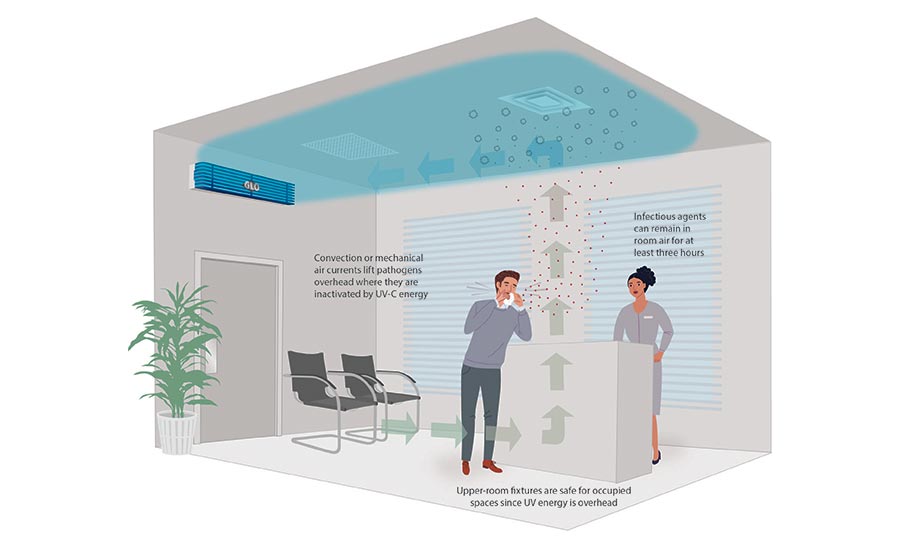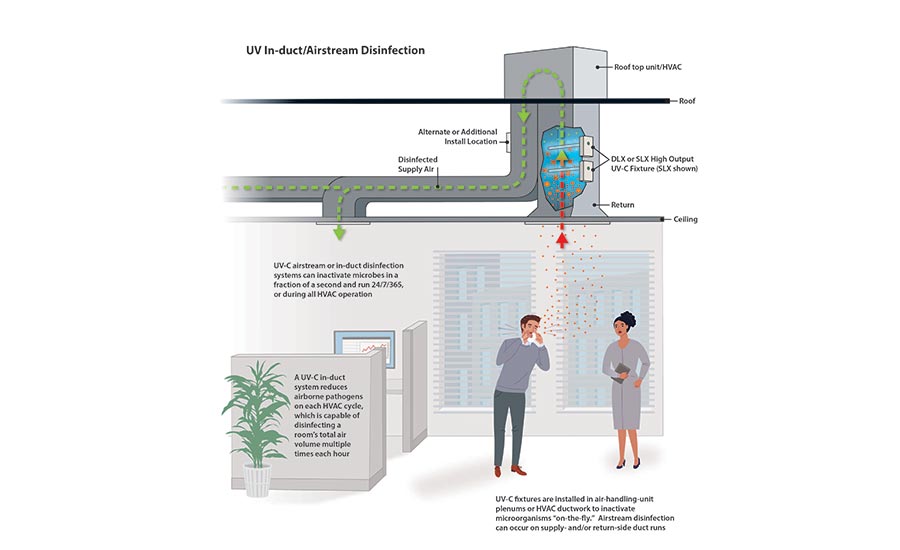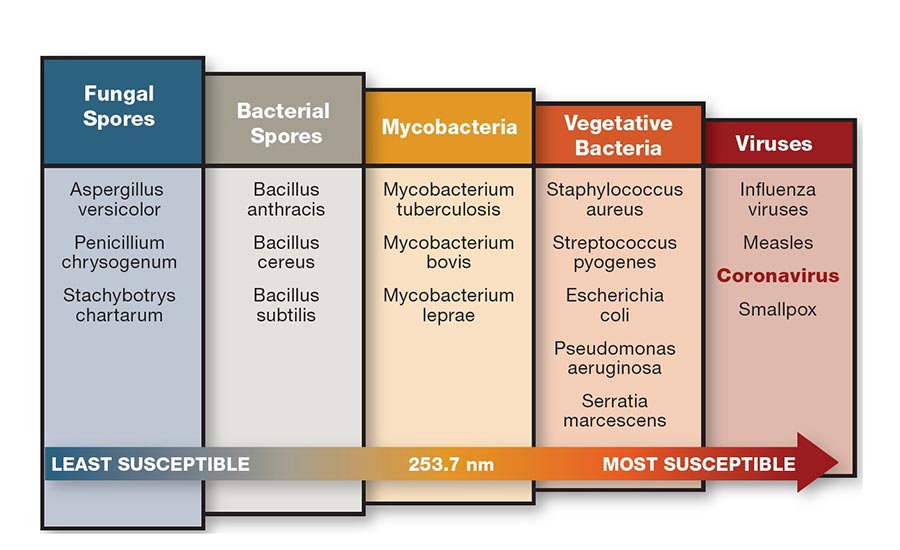Hundreds of scientific studies over the past century have proven the disinfectant efficacy of Ultraviolet Germicidal Irradiation (UVGI or UV-C) energy, having first inactivated viruses and other microbes on surfaces in 1877, in water in 1910 and in air in 1935.
The 2019 COVID-19 coronavirus pandemic is no exception. Both the U.S. Centers for Disease Control and Prevention (CDC) and ASHRAE include UV-C as a recommended mitigation step to slow the spread of the SARS-CoV-2 virus.
Inactivating infectious pathogens
The UV-C electromagnetic radiation is well-absorbed by microbial DNA and RNA, which alters the microbe’s protein structure and renders the cell inactive and unable to replicate. Through a process known as photodimerization, this electromagnetic damage destroys a cell’s nucleic acids and disrupts its genetic building-blocks, preventing microorganisms from infecting and reproducing. What’s more, there are no chemicals, VOCs or dangerous byproducts produced by UV-C energy.
There are three primary means of applying UV-C for air and HVAC surface protection against infectious agents:
- Upper-Room or Upper-Air;
- HVAC airstream disinfection; and
- HVAC coil/surface irradiation.
Upper-room/air systems: Wall-mounted seven-feet and higher, upper-room UV-C fixtures generate a germicidal zone near a room’s ceiling where infectious pathogens are quickly inactivated. The natural rise-and-fall of convection or mechanical air currents lift pathogens overhead where they are inactivated in a matter of seconds (see Figure 1).

Upper-Room germicidal fixtures are wall-mounted seven-feet or above and use baffles to direct the UV-C energy upward and outward ensuring that no UV-C energy enters the occupied portion of the room. Courtesy of UV Resources.
And since UV-C energy is overhead, upper-room fixtures are safe for occupied spaces. Inactivation ratios of up to 99% have been modeled, with concentrations further reduced with each subsequent pass of recirculated air (multiple dosing).
HVAC airstream-disinfection systems: UV-C airstream or in-duct disinfection systems can inactivate a microbe in a fraction of a second. UV-C fixtures are installed in air handling unit plenums or HVAC ductwork to inactivate microorganisms “on-the-fly.”
A UV-C in-duct system reduces airborne pathogens on each HVAC cycle, which can disinfect a room’s total air volume multiple times each hour. As seen in Figure 2, airstream disinfection can occur on the supply- and/or return-side duct runs.

In-duct germicidal UV-C systems are installed in air-handling units or air distribution systems to inactivate microorganisms and disinfect moving airstreams “on-the-fly”— as well as on HVAC surfaces. Courtesy of UV Resources.
Coil/surface-irradiation systems: These are primarily installed within HVAC air-handling units to destroy bacteria, viruses and mold that settle and proliferate on HVAC coils, air filters, ducts and drain pans (see Figure 3). UV-C prevents these areas from becoming microbial reservoirs for pathogen growth that can eventually be circulated by HVAC systems. While not specifically designed for airstream disinfection, an HVAC surface irradiation system can also provide first-pass inactivation ratios of airborne pathogens of up to 30%, along with the primary benefits of restored cleanliness, improved heat-exchange efficiency and lower energy use.

Courtesy of UV Resources.
Pathogen susceptibility to germicidal UV
Bacteria and viruses vary in susceptibility to UV energy, with environmental organisms, fungal spores and mycobacteria being relatively harder to kill than more rapidly replicating and non-environmental microbes and most bacteria. But even fungi are killed effectively with high-dose UV-C. For example, studies have demonstrated that viruses are more susceptible to UV-C inactivation than typical bacteria (Figure 4).

Germicidal UV-C Inactivation of Microorganisms by Group. Data Source: ASHRAE Handbook— HVAC Applications, Chapter 62. Courtesy of UV Resources.
In general, the effectiveness of UV-C air disinfection boils down to time and intensity, (i.e., how much time a pathogen is exposed to the UV-C energy will determine how much UV-C intensity is required.)
There are many operational conditions that factor into this equation including the target pathogen and its susceptibility to UV-C; the amount of airflow (volume and velocity); the air temperature and RH; the length of exposure time (duct length); and the duct material reflectivity. Each of these factors into the amount of UV-C energy necessary in any given application (installations are typically modeled to help predict individual dosage levels.)
It is important to note that UV-C operates by line-of-sight; it can only inactivate what it can see (i.e., the inside of a closed drawer cannot be disinfected unless the drawer is exposed to the UV energy.)
Fixture placement
When designing a germicidal-UV disinfection system, engineers should consider the location within the AHU and its impact on performance.
The application of UV-C for coil irradiation/surface cleaning applications has become more popular over the past 25 years. Lamps are typically installed downstream of the cooling coil to address pathogen growth due to the presence of coil condensation and wet drain pans — both can serve as microbial breeding grounds.
Today, many building engineers are converting their existing UV installations into airborne disinfection applications by simply installing additional UV-C lamps to inactivate airborne viruses. Others are installing new systems downstream of the cooling coil to obtain the benefit of airborne inactivation and coil/drain pan irradiation.
Installation of lamps upstream of a coil (Figure 3) can leverage higher lamp output with the warmer environment (70° F average upstream versus. 55° F average downstream) to enhance airstream disinfection. For upstream applications, engineers need to specify UV-C safe air filters to prevent degradation by the germicidal energy.
Conclusion
Although germicidal UV-C systems have been used successfully for more than 80 years, their application in infection control settings has waxed and waned.
Given the increased focus on the prevention of airborne transmission of infectious diseases, facility professionals can utilize germicidal ultraviolet technologies to greatly reduce concentrations of pathogens in a highly reliable and cost-effective fashion.
In fact, ASHRAE’s position document on infectious aerosols (April 2020) identifies germicidal UV-C energy as a proven method of controlling airborne infections, alongside ventilation and particle filtration.
Recent guidance from ASHRAE, the CDC and published technical articles in HVAC trades provide building engineers and facility staff with the resources needed to size, select, install, operate, and maintain UV airstream disinfection systems.





